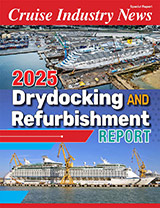Trinidad and Tobago is spending $12 million to create a new, three-berth cruise pier and cruise terminal in the new cruise port of Scarborough on Tobago and another $1.2 million to convert a massive unused shed to a new cruise terminal at Port-of-Spain.
The two-island nation, which neglected tourism in the 1970s when extensive oil resources created a seemingly endless cash flow, is developing its cruise facilities as part of a new, much more aggressive policy of attracting more cruise ship calls during its “relatively hard” economic times the past few years.
Port officials said that they recently slashed cruise ship towing fees from $1,648 to $100 per vessel, waived all barge fees for refueling vessels, will offer volume fuel discounts of 10 to 15 percent and that the average berthing rate in Port-of-Spain has dropped to $1,000 per ship call.
“We basically ran a negative marketing campaign for our cruise facilities in the past because our economy was good when oil prices were high and we simply didn’t think we needed either tourism or cruise lines,” said Eddison Doyle, Marketing Manager for the port. “We’ve always had cruise facilities comparable to Barbados, St. Lucia and Antigua and now we’ll have better facilities and will be aggressively promoting them because oil prices are down and we need the cold, hard cash.”
While tourism officials stressed that their major efforts are centered on attracting a cruise ship to homeport at Port-of-Spain in Trinidad, the new one year-old government will spend about 10 times as much money to create a completely new cruise port in downtown Scarborough on the much-more-sedate island of Tobago.
Tobago has atracted almost twice the number of ship calls as Port-of-Spain over the past few years and ships that call there will no longer be forced to anchor off Pigeon Point on the southwestern coast once the Scarborough facility is completed next winter.
Doyle said that the new Trinidad and Tobago government is actually creating a new deep-water harbor in downtown Scarborough that will include two, 620-foot finger piers that will jut out at right angles to the dock. Doyle said that piles will be dropped and the area around the pier will be dredged from its present depth of 11 feet to 31 feet and that the new port will eventually be able to berth three cruise ships at once upon completion early next year.
Passenger Terminals
Doyle also said that Phase II of the Scarborough project will include construction of a one-story, brick cruise passenger terminal that will house several duty free shops and offices relating to passenger services. Doyle noted that Scarborough has a population of about 35,000 and a “small town atmosphere” and that ships on traditional southern Caribbean sailings call on Tobago because of its many beaches.
The government is also converting a galvanized aluminum shed alongside the existing pier in downtown Port-of-Spain into a new, two story cruise terminal, Doyle said, that will house 40 boutiques and shops, two new restaurants and a local crafts market. Doyle noted that new tourism offices will be installed on a newly constructed mezzanine floor to house the recently restructured “and much more aggressive” Tourist Development Authority when the terminal is completed on June 1.
Doyle said that the port is also trying to offer cruise lines the possibility of using a second unused, sister shed adjacent to the new cruise terminal at Port-of-Spain for storage space in return for homeporting a vessel there. He noted that both the newly converted shed and the still-unused shed have some 40,000 square feet of potential office and shopping space alongside a 6,562-foot pier that can actually berth 11 cruise ships at once.
Task Force
Port chairman Carlos John said that Trinidad and Tobago created a new seven-member Cruise Industry Task Force last fall, hired Arthur Averbook Associates of Miami as a cruise consultant and has greatly expanded its presence at industry trade shows. John said that Trinidad and Tobago has set a “realistic goal” of attracting some 90,000 cruise passengers on 110 ship calls next winter in a bid to tap some of the 27 percent growth in ship calls in the southern Caribbean last year.
John also said that the number of ship calls at Trinidad and Tobago will drop about 40 percent to a total of about 50 this winter season from 74 last year, 64 during 1986-87 and 56 during 1985-86. John noted that each cruise passenger spends an average of $50 on the islands and that some 17,000 cruise passengers stopped there during the last two winter seasons.
Tourism advisor Winston Borrell said that the runway at Piarco International Airport in Trinidad will be extended from its current 7,500-feet to about 9,000-feet by April 30 and that BWIA will increase its daily flights to Miami from two to three next Dec. 15. Borrell added that 227-hotel rooms are currently under construction in Tobago and that the government was in the process of finalizing contracts for the construction of two new resort hotels on Tobago.
Borrell also said that a British development company has plans to develop a major resort hotel on the North Coast of Trinidad near Las Cuervas Bay or Maracas and predicted that two or three new resorts would be built on the North Coast by the early 1990s. He noted that a recent government tourism study concluded that the North Coast of Trinidad is ripe for tourist development and recommended that the government work to attract resort development there over the next few years.



